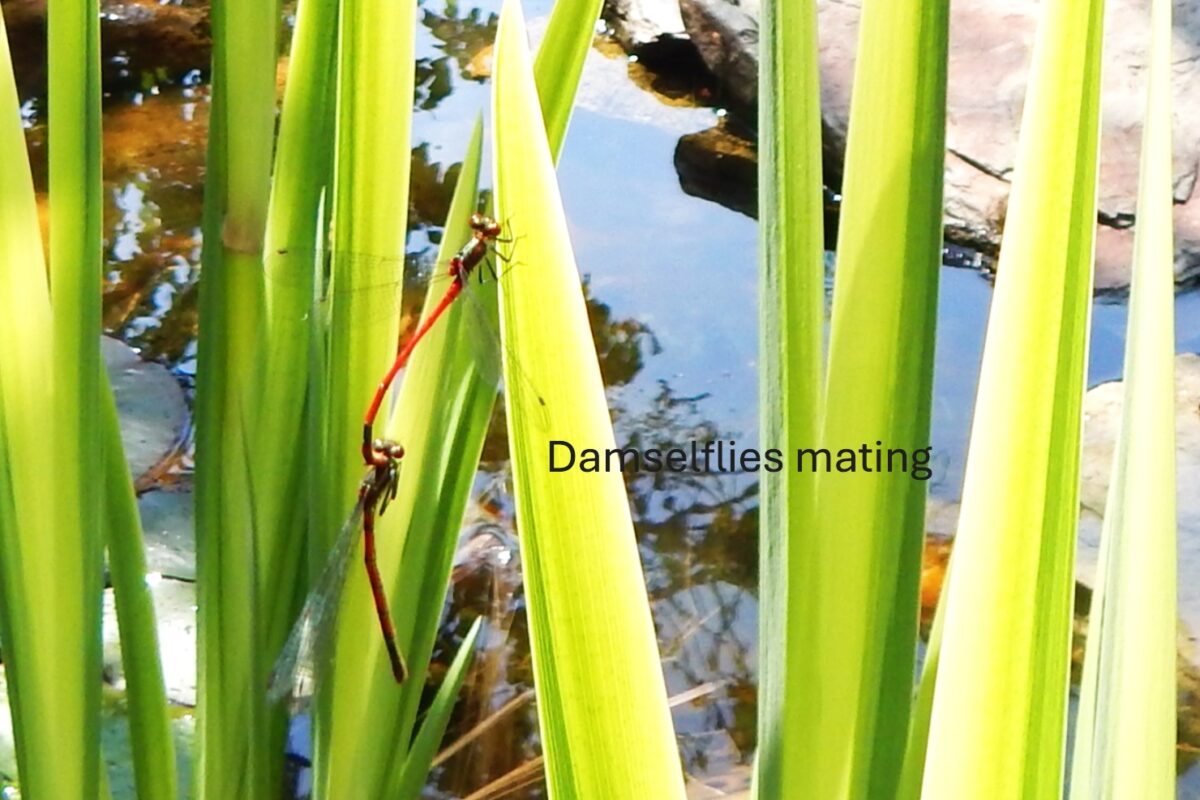Damselflies are mating over the pond. The male grasps the female around the head. He flexes his abdomen to encourage the female to loop her abdomen round to interlock with him, forming the ‘wheel’ position where mating takes place. They have spent two years as larvae at the bottom of the pond, before emerging as adults. The adults live for only a few more weeks, so their priority is mating. She will lay her eggs on any emerging leaf on the pond. In our pond, that is likely to be the iris spears.
The weather is hot and dry, with no rain forecast in the near future. I was in the shelter writing notes for this blog at 11.45 am and the thermometer on the container wall registered 27.2 degrees, half an hour later it said 29.8 degrees, with the sun still not at its highest point. That will be at 1.00 pm as we are on Summertime. This temperature is not be same the as the external temperature, as, within the shelter, heat is to some extent trapped by the roof, and so is higher than outside.
The water in our barrels is going fast these hot days as we water the garden, especially the plants in pots. The wildflower bed has been sown with fresh seed. The bed needs a good soaking or the seeds will not germinate. Watering is best done in the evening when it is cooler, so less evaporates.
I am trying to propagate crownwort, a pond oxygenator. I have a plastic box, full of water and a few plants, in a sunny spot by the pergola, and a large jar in the greenhouse. The former will get more sunlight and the latter more heat. I set them up last week with a little tomato fertiliser in the water, but after a few days, I saw they were dying. Presumably because of the effect of the fertiliser. I threw away the plants and the water they were in, and set the two sites up again. This time with pond water alone, with the crownwort we hope to propagate.
The warm weather has brought our many flowers: aquilegia (white and blue varieties), bluebells, three baskets of sedum spatulifoleum with their yellow flowers, handing from the small pergola, the perennial wallflower continues flowering, as do the marigolds. There’s a pink oxalis by the sycamore which is now in full leaf.
There are female catkins on our walnut tree. But all the male catkins have gone. I assume this is to prevent self fertilisation. But it means we won’t get any walnuts unless there is a walnut tree in a garden nearby. We have only ever had a single walnut on the tree. Next year, we should keep some of the male catkins until the female ones arrive and pollinate them ourselves.
The buddleia is growing quickly. The tallest branches are over ten feet high. Called the butterfly bush as butterflies are attracted by its flowers. Though, I have seen few insects this year. A few bees, a lone ladybird, the occasional butterfly but not much else. Insects numbers have been dropping in the last decade, as indicated by measurements of windscreen splatter. Few as they are, hot, dry weather cuts numbers down all the more. Like any animal life, they need water, and being small cannot store much.
The hawthorn near the front gate is in glorious bloom, a plethora of white flowers. They are celebrated in the nursery rhyme Nuts in May, as the hawthorn is also known as the may tree, and branches of its blossom were known as knots, hence nuts. These were taken into houses and churches. There are, of course, no actual nuts in May.
There is a saying: Ne’er cast a clout until May is out. There are two possible meanings to this. The first is: keep all your clothes on till the month has ended. The second is: keep all your clothes on till the may tree is in bloom. I am inclined to go for the latter, as the month of May can get very warm, even before climate change, and so you would want to take off clothing well before the end of the month. In fact, May 1st this year, was the hottest start of the month on record, 29.3 degrees at Kew.
On Bank Holiday Monday we’ll be at the Green Fair in Plashet Park, from 11 to 4, along with lots of other stalls. Then on Thursday, we’ll be celebrating the 80th anniversary of VE Day, the end of WWII in Europe. We’ll have tea and cake and share family memories of those days.

